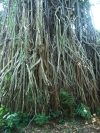 Cambodian villagers fighting to save their forest from rubber companies have been rebuked by the local government. Local authorities prevented some 400 Cambodian villagers from protesting at the offices of the Vietnam-based CRCK Company, which the villagers contend are destroying their livelihoods by bulldozing large swaths of primary forests. Authorities said they feared the villagers would have grown violent while protesting. But village representative, Chheang Vuthy, told to the Cambodia Daily a different truth: "The villagers would not have acted violently. The companies should not be clearing forest even though they have licenses from the government because it affects people's livelihoods."
Cambodian villagers fighting to save their forest from rubber companies have been rebuked by the local government. Local authorities prevented some 400 Cambodian villagers from protesting at the offices of the Vietnam-based CRCK Company, which the villagers contend are destroying their livelihoods by bulldozing large swaths of primary forests. Authorities said they feared the villagers would have grown violent while protesting. But village representative, Chheang Vuthy, told to the Cambodia Daily a different truth: "The villagers would not have acted violently. The companies should not be clearing forest even though they have licenses from the government because it affects people's livelihoods."
The Cambodian government has granted a concession of over 6,000 hectares to the rubber company from the 200,000 hectare forest known as Prey Lang. Located between the Mekong and Stung Sen River, nearly half of Prey Lang has never been logged, making it an incredible rarity in Southeast Asia. Tigers, Asian elephants, banteng, gaur, and Asiatic black bears are all still found in Prey Lang. In all 26 to 50 endangered mammals, birds, and reptiles may live in Prey Lang. Still provincial authorities have dubbed Prey Land a 'dull forest'.
View Larger Map
A part of Prey Lang forest as viewed from Google Earth. The Mekong River is to the east (right side of the image).
In addition to its wildlife, the largely unprotected forest is also home to a quarter of million people who are dependent on its resources.
At a press conference held by a group comprising over 100 local NGOs, villagers said authorities were using intimidation tactics to halt protests, including send police to gather names of those villages inciting protests: "[Police] have tried to find many ways to threaten us, but we were protesting to save Prey Lang forest," Chheang Vuthy told the Phnom Penh Post. Governor of the Sandan district, Sim Vanna, denied any knowledge of police gathering names in the villages.
Local authorities say the concession in question is not in communal land and therefore open for development. But the protesters say the companies involved are not being forthright. "This bulldozing of the forest is done without any environmental impact assessments," Chet Ton, a community organizer with a local NGO, told the Cambodia Daily, "and the companies try to hide [information]."
A national lawmaker, Son Chhay, stepping into the fight by appealing to Cambodia's National Assembly President Heng Samrin to come to the villages' aid: "Please, National Assembly president, use the power of the legislative branch to stop destroying Khmer forests by Vietnamese companies, in order to preserve what's left of the forest for the next generation."
Cambodia is experiencing a rubber boom after the Vietnamese Rubber Enterprise Federation (VREF) invested $600 million. VREF was awarded 100,000 hectares in 2009 and is expected to gain 70,000 hectares more by 2012 according to the Phnom Penh Post.
However, Cambodia's Prime Minister, Hun Sen, has spoken out against going too far with rubber plantation: "Rubber is at a good price, but it is [wrong] for us to cut down the high trees to plant rubber - he told university students - We can protect the forest to help reduce climate change." Nice speech. However, the Prime Minister recently signed over 9,000 hectares of Vereak Chey National Park for conversion to rubber plantations despite it being a protected area.


